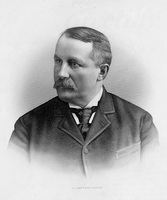 | Back to e-WV
| Back to e-WV
 The West Virginia Encyclopedia
The West Virginia Encyclopedia
 | Back to e-WV
| Back to e-WV
 The West Virginia Encyclopedia
The West Virginia Encyclopedia

Geologist Israel Charles White (November 1, 1848-November 25, 1927) was born in Monongalia County. In 1867, he was one of the first six students to enter the Agricultural College of West Virginia (now West Virginia University). He earned undergraduate (1872) and master’s degrees (1875) there, and received an honorary law degree in 1919. White returned to WVU to teach geology in 1877. He later worked for the Pennsylvania Geological Survey (1876–83) and the U.S. Geological Survey (1884–88). White was one of the 13 founders of the Geological Society of America.
White was noted for the practical application of geology. In 1885, in an article in the journal Science, he asserted his discovery, or rediscovery, of the anticlinal theory in the location of oil and gas. His application of the theory to drill producing wells provided him with financial security and put him in great demand with oil and gas companies in developing fields in Arkansas, Oklahoma, Louisiana, Texas, and Mexico.
White was West Virginia’s first state geologist, appointed in 1897 and serving until his death in 1927, working without pay for all but two of those years. He took up the ambitious work of mapping the state’s topography and geology and inventorying its resources. White supervised the work on the complete set of state topographic maps, as well as special resource maps, and 34 book-length reports on specific resources and single or multiple county reports. While his reputation was that of an oil and gas geologist, his work in coal geology included extensive publications on Pennsylvania and the Appalachian basin, and a 1908 report on the coal resources of Brazil.
Developing an interest in resource conservation, White was invited by the Theodore Roosevelt administration to speak at the first White House Conference on Conservation in 1908. He continued to publish articles, present speeches, and provide state leaders accounts of wasteful and unnecessary loss of resources through abusive exploitation. He advocated legislation establishing the U.S. Bureau of Mines, following the disastrous 1907 mine explosion at Monongah.
Locally, White was a promoter and developer, and an owner of businesses and residences in the Morgantown area. Many of his properties were to become part of the WVU campus, including the earlier site of the president’s home. The main library and the mineral industries building stand on the site of White’s former home, Cherryhurst, and the stadium and hospital are on a portion of a golf course property he helped develop. He also invested in banking and manufacturing, including brick and tin manufacturing, and the residential development of South Park. White helped to build old Mountaineer Field, as treasurer of the building committee and a major fundraiser. As WVU’s oldest alumnus he wrote an invaluable memoir of the university’s early years.
I. C. White died following surgery in Baltimore.
Written by Fredrick H. Armstrong
Fairchild, Herman L. Memorial of Israel C. White. Reprinted from Bulletin of the Geological Society of America (3/30/1928).
Hennen, Ray V. Israel Charles White Memorial. Reprinted from Bulletin of the American Assn. of Petroleum Geologists (Mar. 1928).
White, I. C. The Geology of Natural Gas. Science, (June & July 1885).
Brown, Lloyd L. "The Life of Dr. Israel Charles White." M.A. thesis, West Virginia University, 1946.
Papers of Israel C. White. West Virginia & Regional History Collection, West Virginia University Libraries.
Price, Paul H. "Israel Charles White, Geologist (1848-1927)," Manuscript copy presented to Upsilon Chapter, Morgantown, Feb. 5, 1958. .
White, I. C. "The Waste of our Fuel Resources," Address of I.C. White, State Geologist of West Virginia, at the Conference of Natural Resources, the White House, May 13, 1808. .
White, I. C. "Stratigraphy of the Bituminous Coal Field of Pennsylvania, Ohio and West Virginia," Bulletin 65. United States Geological Survey. United States Government Printing Office, 1891.